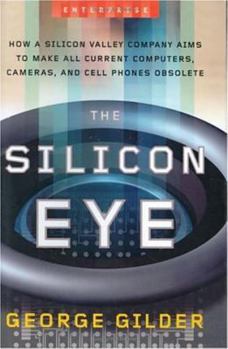The Silicon Eye: How a Silicon Valley Company Aims to Make All Current Computers, Cameras, and Cell Phones Obsolete
Select Format
Select Condition 
Book Overview
Thanks to the digital technology revolution, cameras are everywhere--PDAs, phones, anywhere you can put an imaging chip and a lens. Battling to usurp this two-billion-dollar market is a Silicon Valley company, Foveon, whose technology not only produces a superior image but also may become the eye in artificially intelligent machines. Behind Foveon are two legendary figures who made the personal computer possible: Carver Mead of Caltech, one of the...
Format:Hardcover
Language:English
ISBN:0393057631
ISBN13:9780393057638
Release Date:April 2005
Publisher:W. W. Norton & Company
Length:318 Pages
Weight:0.05 lbs.
Dimensions:1.1" x 6.3" x 8.4"
Customer Reviews
2 ratings
The Digital Camera is creating a breakthrough digital revolution
Published by Thriftbooks.com User , 19 years ago
The Digital Camera is creating a digital revolution. Craver Mead is leading the digital revolution. The Japanese pushed CCD technology creating a $20 billion industry for digital cameras and cam recorders. CCD dicards 2/3 of its light values and uses forward propagating Neutral Networks of surrounding pixels to calculate pixel color. The Foveon chip can collect 100% of the color information per pixel using a single-chip solution and the impact will be smaller imaging, cheaper cost, higher quality, and less power power consumption. As computer computation levels increase, it seems very probable that the Foveon chip will be capable of transferring electrical signals with high connectivity and integrated connectors directly into the retina for transmission to the brain, a computer chip capable of restoring sight. Mead discovered that retina power voltage did not increase but that connectivity increased. Misha brought to light the biological mechanics of how the retina worked. Mead used Misha's work to build a silicon prototype of the retina. The threshold value is 120 million silicon rods matching the biological equivalent in the retina. In the future, the Fovean chip processor will follow in the success path of the digital signal processing hearing device. Hopfield network. Misha research helped explain how the retina process images and color by measuring delta changes caused from movement. Feedback was critical and the Hopfield network provided the answers Misha need to explain image processing. Misha help bridge the chasm between the biology of the eye and the electrical engineer skill that Mead could provide. Eventually, Mead, Feinstein, and Misha created a digital camera based on retina modeling. The Hopfield network seemed to adequately explain how the brain intreprets visual input by measuring delta changes through feedback loops. Federico Fagin brought the right products, too market, at the right time. Fagin built the first microprocessor,the Intel 4004 microprocessor, it contained 2300 transistors on a 7 mm by 7 mm silicon chip and can process 4 bits at a cycle rate of 60,000 per second. The silicon solution removed the need for metal connectors and introduced lithographic technics for etching transistors on silicon wafers. Fagin understanding of silicon fabrication and his innovations became critical for Mead. Transister. Variable length transistors simulated weighting of the Nodes on the Neural Network. The Neural networks and silicon transisters helped the Synaptics team build a MICR recognition system. The team used EEPROM, programable weights, and two chip character recognition system. The machine could see and recognize between than the robotic vision systems doing input and output comparisons. Meads team opened the potential for machines to interpret input information, at a new level of sophistication. Touch pad. The Synaptics team also went on to build a touch pad system for laptop computers taking 100% of
Gilder successfully chronicles an important technology advance
Published by Thriftbooks.com User , 19 years ago
In "The Silicon Eye" George Gilder relates another colorful story of a significant technology breakthrough, namely, a camera imaging chip that is greatly superior to everything else out there. Standard imagers work by separating the three primary colors, throwing away 2/3 of the color information at each point in the visual field, and must use software processing to interpolate the missing data. The Foveon chip is a major advancement because it can collect 100% of the color information at each point using a single-chip solution that will provide smaller and cheaper imaging that is of both higher quality and lower power consumption. The photo samples on Foveon's web site are truly astounding. But Gilder's book over-hypes the significance of the technology. It will not "Make All Current Computers, Cameras, and Cell Phones Obsolete." Cameras, yes. And cell phones and computers will benefit greatly from the smaller, lighter, cheaper, lower power consumption, and higher image quality aspects of the Foveon chip. But the Foveon chip is not a "Silicon Eye" as Gilder suggests. The chip does not "see" the way a biological eye does - it merely records images as all cameras do. The story of Foveon's initial forays into AI and producing silicon chips that mimic brain functions is fascinating, but as Gilder describes, Foveon finally had to abandon such speculative research in favor of a viable commercial product.






